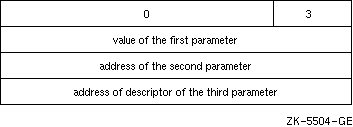
The OpenVMS Calling Standard describes the concepts used by all OpenVMS languages to invoke routines and pass data between them. It also describes the differences between the VAX and Alpha parameter-passing mechanisms. The OpenVMS calling standard specifies the following attributes:
The following sections discuss these attributes in more detail for OpenVMS VAX systems. For more detail on OpenVMS Alpha systems, see the OpenVMS Calling Standard.
The calling standard also defines such attributes as the calling sequence, the argument data types and descriptor formats, condition handling, and stack unwinding. These attributes are discussed in detail in the OpenVMS Programming Interfaces: Calling a System Routine.
The calling standard defines several registers and their uses, as listed in Table 3-1 for VAX systems and Table 3-2 for Alpha systems.
| Register | Use |
|---|---|
| PC | Program counter |
| SP | Stack pointer |
| FP | Current stack frame pointer |
| AP | Argument pointer |
| R1 | Environment value (when necessary) |
| R0, R1 | Function return value registers |
| Register | Use |
|---|---|
| PC | Program counter |
| SP | Stack pointer |
| FP | Frame pointer for current procedure |
| R25 | Argument information register |
| R16 to R21, F16 to F21 | Argument list registers |
| R0 | Function return value register |
By definition, any called routine can use registers R2 through R11 for computation, and the AP register as a temporary register.
In the calling standard, a stack is defined as a last-in /first-out (LIFO) temporary storage area that the system allocates for every user process. The system keeps information about each routine call in the current image on the call stack. Then, each time you call a routine, the system creates a structure on this call stack, known as the call frame. The call frame for each active process contains the following data:
When a routine completes execution, the system uses the frame pointer in the call frame of the current routine to locate the frame of the previous routine. The system then removes the call frame of the current routine from the stack.
Figure 3-1 shows the call stack and several call frames for VAX processors. Function A calls function B, which calls function C. When a function reaches a return statement or when control reaches the end of the function, the system uses the frame pointer in the call frame of the current function to locate the frame of the previous function. It then removes the call frame of the current function from the stack.

A function is a routine that returns a single value to the calling routine. The function value represents the value of the expression in the return statement. According to the calling standard, a function value may be returned as either an actual value or a condition value that indicates success or failure.
The OpenVMS Calling Standard also defines a data structure called the argument list. You use an argument list to pass information to a routine and receive results.
On OpenVMS Alpha systems, an argument list is formed using registers R16 to R21 or F16 to F21, and a collection of quadwords in memory (depending on the number and type of the arguments).
On OpenVMS VAX systems, an argument list is a collection of longwords in memory that represents a routine parameter list and possibly includes a function value. Figure 3-2 shows the structure of a typical OpenVMS VAX argument list.

The first longword must be present; this longword stores the number of arguments (the argument count: n) as an unsigned integer value in the low byte of the longword with a maximum of 255 arguments. The remaining 24 bits of the first longword are reserved for use by Digital and should be 0. The longwords labeled arg1 through argn are the actual parameters, which can be any of the following addresses or value:
The argument list contains the parameters that are passed to the routine. Depending on the passing mechanisms for these parameters, the forms of the arguments contained in the argument list vary. For example, if you pass three arguments, the first by value, the second by reference, and the third by descriptor, the argument list would contain the value of the first argument, the address of the second, and the address of the descriptor of the third. Figure 3-3 shows this argument list.

For additional information on the OpenVMS calling standard, see the OpenVMS Calling Standard.